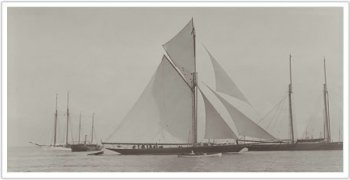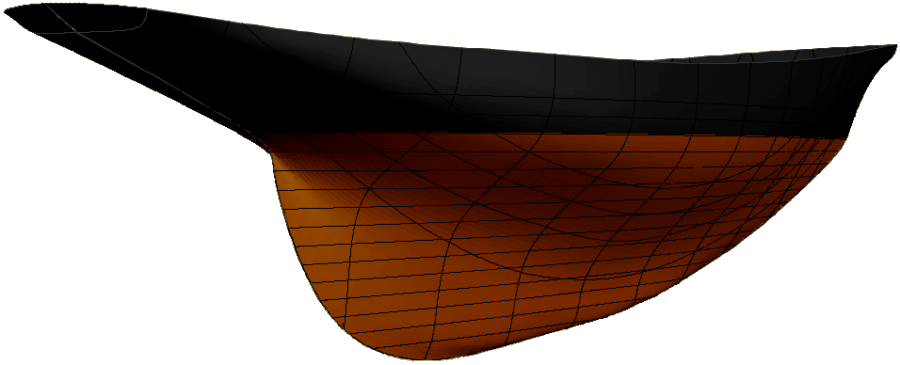Yves GARY Hits: 6633
Category: THISTLE
 Lord Dunraven says of the Thistle : "Thistle was built for the express purpose of sailing for the cup... She was built for the purpose and was the best thing we could turn out."
Lord Dunraven says of the Thistle : "Thistle was built for the express purpose of sailing for the cup... She was built for the purpose and was the best thing we could turn out."
The money for building the new boat was subscribed by Messrs. John Clark, Commodore of the Royal Clyde Yacht Club, William Clark, Andrew Coates, William Coates, James Coates, George Coates, J. Hilliard, James Bell, Vice-Commodore of the Royal Clyde Yacht Club, and William Bell.
The designer was Mr. George L. Watson, the most skilful naval architect in the British Isles. Aided by the knowledge gained from a careful study of our yachts and the waters in which the Cup races in America are sailed, he delivered to the syndicate the plans of a cutter which was destined to eclipse the performances of all of England's most famous racers.
 The new boat, which was subsequently named the Thistle, was built by Messrs. D. & W. Henderson, at Partick. The utmost secrecy in regard to her was preserved from the outset. The yard in which she was built was kept securely locked, and every effort was made to keep her water-line length a secret. Even when she was launched, on April 26, 1887, she was covered with canvas, to hide her lines from the eyes of the public.
The new boat, which was subsequently named the Thistle, was built by Messrs. D. & W. Henderson, at Partick. The utmost secrecy in regard to her was preserved from the outset. The yard in which she was built was kept securely locked, and every effort was made to keep her water-line length a secret. Even when she was launched, on April 26, 1887, she was covered with canvas, to hide her lines from the eyes of the public.
The Thistle is a steel cutter, and differs from the modern English cutter in having her forefoot more cut away and in her greater beam. Her sides are much rounder, and flare up from the load water-line to the plank sheer. Her hull is plated with the best Siemens-Martin steel, the lower plates being three-quarters, and the upper five-sixteenths, of an inch thick. The three lower strakes have lap seams, but the top body is plated flush. The frames are of unusual strength, and are tied by steel diagonals, stringers, keelsons, and floorings, forming a network of the most secure description. Partial bulkheads give still further strength, and there is also, forward, a collision bulkhead. The keel is of lead, which weighs about seventy tons, and is placed about three feet lower than is the Volunteer's . Her channels and chain-plates are placed outside, as usual on English vessels. The stern-post shows considerable rake, and the bow is a clipper one, and very handsome. She has a reefing bowsprit, which can be shortened six feet.
 The sweep of the deck is particularly easy. The covering boards are of teak, and the deck fittings, which are of the same material, are arranged to give the greatest possible space for the handling of the yacht. Her bulwarks are low, mahogany-stained inside, and finished with a neat rail of elm. The companion-way is handsomely finished in teak and mahogany, and the main saloon in American walnut. The latter is very roomy, of the full width of the yacht, is upholstered in cretonne, and is handsomely furnished. A ladies' cabin, aft, is conveniently arranged. Just forward of the main saloon are the officers' rooms and the galley, which, with the forecastle, are well furnished and lighted. The forecastle accommodates twenty men, iron swinging berths being used. The main rigging is of steel, and the jib-halliards are of galvanized iron chain.
The sweep of the deck is particularly easy. The covering boards are of teak, and the deck fittings, which are of the same material, are arranged to give the greatest possible space for the handling of the yacht. Her bulwarks are low, mahogany-stained inside, and finished with a neat rail of elm. The companion-way is handsomely finished in teak and mahogany, and the main saloon in American walnut. The latter is very roomy, of the full width of the yacht, is upholstered in cretonne, and is handsomely furnished. A ladies' cabin, aft, is conveniently arranged. Just forward of the main saloon are the officers' rooms and the galley, which, with the forecastle, are well furnished and lighted. The forecastle accommodates twenty men, iron swinging berths being used. The main rigging is of steel, and the jib-halliards are of galvanized iron chain.
The measurements required by the rules of the New York Yacht Club are all that have ever been officially given to the public; but the others, given below, are believed to be correct:
Length over all, 108.50 feet; length on water-line, 86.46 feet; beam, about 20.35 feet; draught, about 13.80 feet; length of mast, from deck to hounds, about 62 feet ; length of top-mast, about 45 feet; length of boom, about 80 feet; length of gaff, about 50 feet; length of bowsprit, outboard, about 38 feet; length of spinnaker-boom, about 70 feet; ballast, about 70 tons ; displacement, about 138 tons ; sail area (New York Yacht Club rules), 8,968 square feet; racing measurement (New York Yacht Club rules), 89.20.
|
|
|||||||||||||||||||||||||||||||||||||||||||||||||||
Plan created with DELFTSHIP

Download the MODEL FOR DELFTSHIP : Hull only
Download the MODEL FOR DELFTSHIP : Full model

